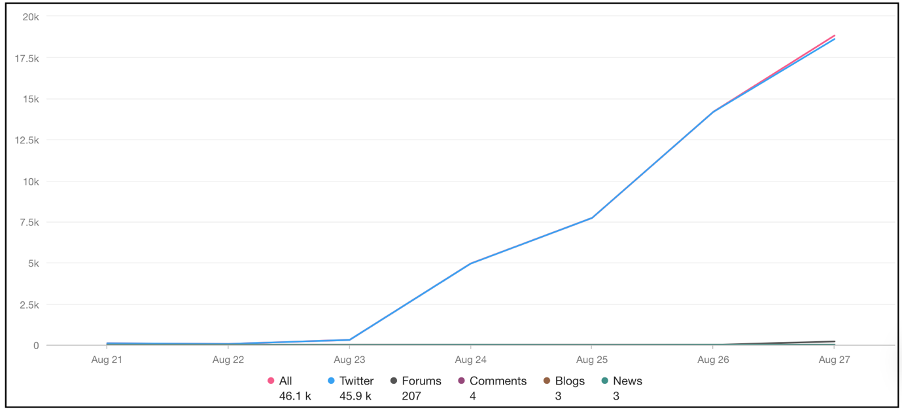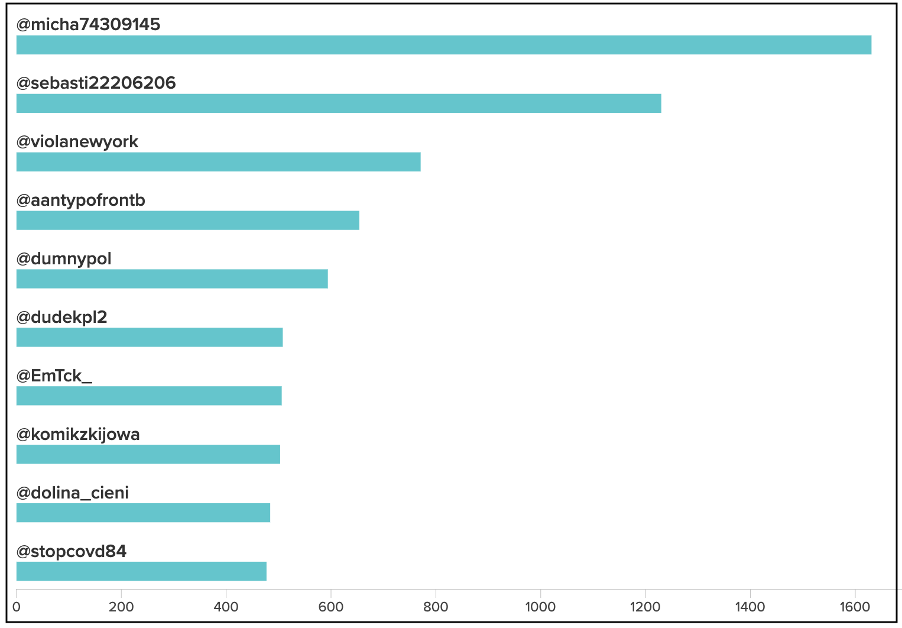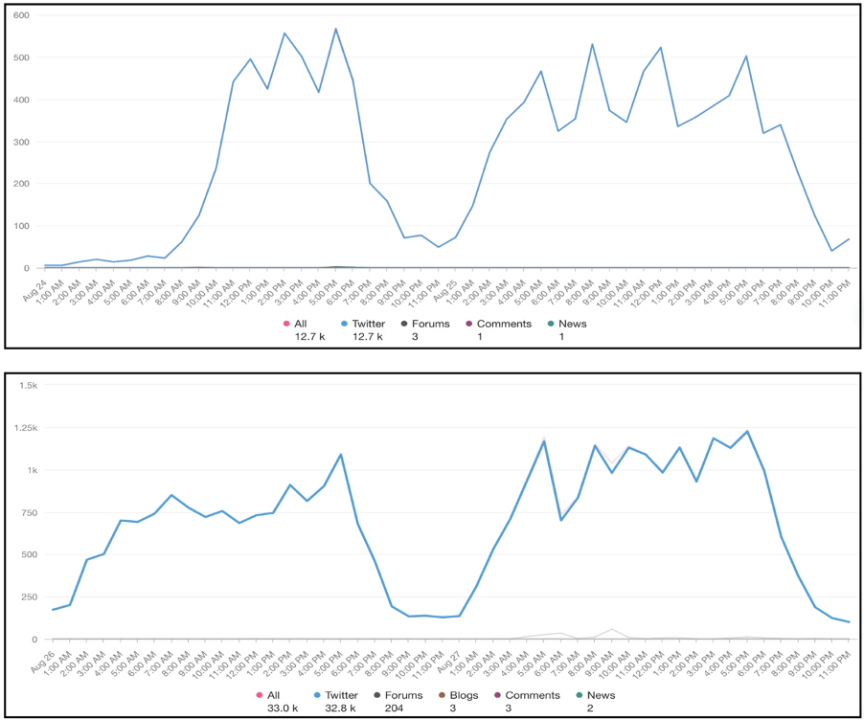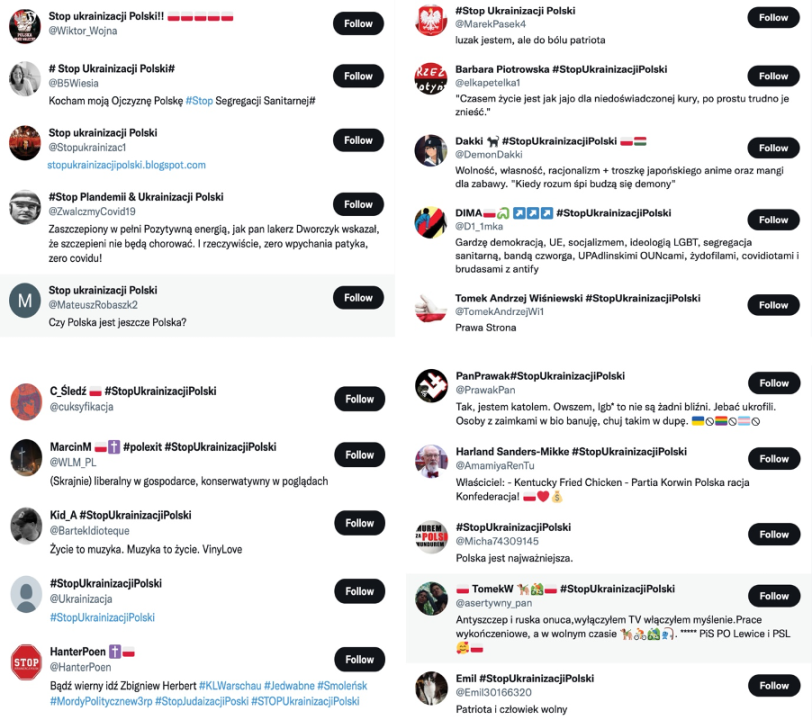Twitter campaign pushes anti-Ukraine hashtag into Poland’s trending list
Largely inauthentic campaign pushed #StopUkrainizacjiPolski to the top of Poland’s trending list over the course of four days.
Twitter campaign pushes anti-Ukraine hashtag into Poland’s trending list

BANNER: Polish MP Grzegorz Braun, second from the left, at the launch of a political initiative in Rzeszow, Poland, July 25, 2022. Braun’s Twitter account was among a handful of authentic accounts that sought to amplify the #StopUkrainizacjiPolski hashtag, which reached Poland’s Trending list largely through inauthentic amplification. (Source: Reuters, Artur Widak/NurPhoto)
On August 24, 2022, the hashtag #StopUkrainizacjiPolski (#StopUkrainizationOfPoland) suddenly began trending on Twitter in Poland, with some accounts openly writing about their intention to boost it into Twitter’s Trending list. The DFRLab determined the campaign was largely inauthentic, as the primary accounts behind its promotion created a false impression regarding its relative popularity in Poland.
The DFRLab has previously reported on the anti-immigration legislative bill “Stop Ukrainization of Poland,” prepared by right-wing political party Confederation of the Polish Crown. The bill proposes legislative initiatives to “protect” Poland from “ethnic, political, and perhaps territorial disintegration” amid the massive influx of Ukrainian refugees. The recent astroturfing campaign utilized the name of the bill as its hashtag.
Grzegorz Braun, leader of Confederation party, amplified the hashtag and tweeted on August 26 that #StopUkrainizacjiPolski was the most popular hashtag on the Polish Internet. However, a DFRLab analysis shows that a small number of very active Twitter accounts, many showing signs of inauthenticity or bot-like behavior, disproportionately amplified this hashtag. Such coordinated campaigns can be qualified as astroturfing, which occurs when a coordinating actor creates a false impression of grassroots support.
A review of Twitter data using the monitoring tool Meltwater Explore showed that around 46,000 tweets mentioned this hashtag between August 24 and 27. A closer look at mentions revealed that a small group of hyperactive accounts promoted the hashtag, with some of these accounts exhibiting signs of bot-like behavior.

The DFRLab analyzed mentions of #StopUkrainizacjiPolski using the Twitter Trending Archive tracker and found that it first appeared in Poland’s trending list around noon Warsaw time on August 24. By 1:11pm that day, the hashtag topped the list of trending hashtags in Poland. After losing the top spot the following day, #StopUkrainizacjiPolski became the top trending hashtag again around 6:40pm local time on August 27. It remained among the top five trending topics in Poland from August 24 to 27.

Identifying the top tweeters
An analysis of the ten most active Twitter accounts promoting the hashtag showed that they posted it 7,385 times between August 24 and August 27. While #StopUkrainizacjiPolski garnered 46,019 mentions from 6,540 users during this period, the top ten most active accounts comprised more than 16 percent of all mentions. Among total mentions, a majority of them came from retweets and replies rather than original tweets, with around 47 percent retweets, 32 percent replies and 16 percent quote tweets.

The hashtag started to gain traction after noon Warsaw time on August 24, reaching more than 560 tweets per hour by 10pm that night. The intensity decreased to fewer than 50 posts per hour by 4am on August 25, then started to grow again at 5am. Mentions of #StopUkrainizacjiPolski spiked three times on August 24, followed by four big spikes and one smaller one on August 25. On August 26, Twitter accounts continued to post the hashtag, with a decrease occurring around 10pm. This turned around two hours later, with posting activity increasing after midnight on August 27.

An analysis of most recent 3,200 tweets from the twelve most active accounts promoting the hashtag showed that @micha74309145, @sebasti22206206, @dumnypol, @dolina_cieni, @Dudekpl2, @komikzkijowa, @emtck_, and @marcinstein recorded their highest daily posting activity after #StopUkrainizacjiPolski started on August 24. In other words, these accounts were less active prior to August 24, at which point they specifically focused on amplifying the hashtag. @Stopcovd84, @aantypofrontb and @MarcinSkalski7 had breaks in their tweet history, during which they did not post any content for some time.
Some accounts, including @micha74309145, @sebasti22206206, @violanewyork and @dolina_cieni, exhibited multiple indicators of bot-like behavior. They posted more than seventy-two times a day, lacked personal information and followed a high level of anonymous Twitter users. Additionally, more than 90 percent of their tweets were retweets or replies rather than original tweets, and their profile photos appeared to have been stolen. Two of the accounts also utilized alphanumeric usernames. According to the DFRLab’s bot identification framework, these characteristics are indicators of bot-like behavior. While this by no means guarantees the accounts were run as actual bots, they demonstrated numerous signs of inauthentic behavior.

Measuring traffic manipulation
The DFRLab also calculated the likelihood of traffic manipulation using the Coefficient of Traffic Manipulation (CTM). Traffic manipulation refers to “an attempt by a small group of users to generate a large flow of Twitter traffic, disproportionate to the number of users involved.” A 2019 DFRLab report on CTM published by the Oxford Internet Institute found that organic, non-manipulated control samples typically scored a CTM of 12 or lower, while inorganic Twitter behavior resulted in scores higher than 12.
CTM is expressed by the equation CTM = (R/10) + F + U, in which R is the percentage of retweets, F is the percentage of tweets from the fifty most active accounts, and U is the average number of posts per user. #StopUkrainizacjiPolski consisted of 47.6 percent retweets, according to Meltwater Explore. The fifty most active accounts generated 34.7 percent of all traffic on Twitter. The 45,716 tweets containing the hashtag came from 6,508 accounts, for an average of seven tweets per user. Utilizing the equation above, #StopUkrainizacjiPolski hashtag achieved a CTM score of 46.4, which is well above the threshold of potential inauthentic behavior, indicating that the hashtag was heavily manipulated.
History of the campaign
The hashtag campaign started to gain traction on August 23 via the account @DudekPL2, which started to actively promote it. @DudekPL2 asked its followers to start posting the #StopUkrainizacjiPolski hashtag to push it into the list of trending topics.
The account posted several times that the hashtag was rising among Poland’s trending topics. On August 25, it posted a screenshot showing that Twitter had restricted the account’s ability to follow other users and like their tweets for three days for violating Twitter’s terms of service. The account claimed that Russian and Ukrainian “agents” reported the account to Twitter, though it did not provide any evidence. On August 26, it wrote that the hashtag had finally made it to first place on the trending list, and boasted that this might force the Polish government to reconsider its policy towards Ukraine.
Another account that called for Twitter users to amplify the hashtag in order to push it to trending topics belongs to Polish right-wing figure Marcin Skalski. Skalski is a former member of the editorial board at the right-wing portal Kresy.pl; he writes articles for Wprawo.pl and Nowakonfederacja.pl.
The DFRLab also found twenty Twitter accounts that incorporated the hashtag into their user name or bio. The majority of these accounts were created prior to the start of the astroturfing campaign started, so they do not seem to have been created to launch this particular campaign.

The available evidence provided above suggests that inorganic traffic manipulation and promotion provided inauthentic boosts to #StopUkrainizacjiPolski. It was amplified by accounts that engaged in suspicious behavior in order to make the hashtag appear more popular than it actually was, alongside authentic accounts that encouraged its promotion. Despite the fact that #StopUkrainizacjiPolski ended up being the top trending topic in Poland for a short period of time, it was not picked up by a broader audience of authentic Twitter users.
Cite this case study:
Givi Gigitashvili, “Twitter campaign pushes anti-Ukraine hashtag into Poland’s trending list,” Digital Forensic Research Lab (DFRLab), August 30, 2022, https://medium.com/dfrlab/twitter-campaign-pushes-anti-ukraine-hashtag-into-polands-trending-list-90ccc9474a60.

